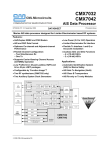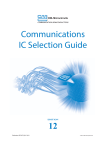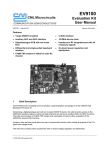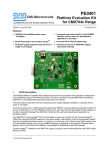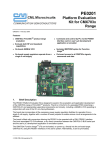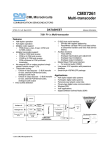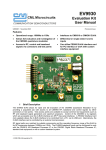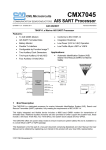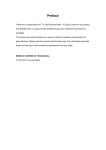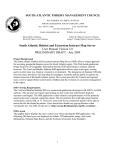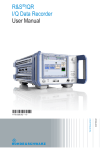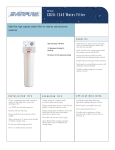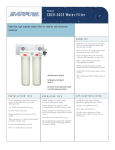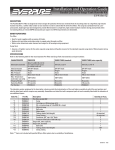Download Marine AIS System Overview
Transcript
CML Marine AIS (Automatic Identification System) Product Information Pack Home June 2009 Introduction System CMX910 CMX7032/42 Slide 1 Promotion Resources Marine AIS – Automatic Information System Introduction The Automatic Identification System (AIS) as specified by the International Marine Organisation (IMO), is a ship and shore based broadcast system, operating in the VHF maritime band. A radio aid to navigation and safety, an AIS transponder repetitively broadcasts its host vessel’s positional and status information. This enables other similarly equipped vessels in the vicinity to receive, decode and display that information, along with information from other navigational systems (radar, GPS, depth recorders), to provide a comprehensive picture of the maritime traffic in the local area. Using the transfer of formatted wireless-data, an AIS system employs two simultaneous Rx channels and a single frequency-switched Tx channel. AIS transactions employ GMSK modulation with a back-up DSC channel using FSK modulation for system control and management. An AIS network normally operates in an autonomous continuous mode and adapts to transponders moving into and out of range. Using Self Organising Time Division Multiple Access (SOTDMA) technology, AIS messages occupy over-air time slots that are accurately synchronized to either a GNSS or a local timebase. An AIS network can handle over 2000 reports per minute using individual 26.6ms time slots. Each network determines its own transmission schedule based upon data-link traffic history and knowledge of future actions by other stations. AIS Class A was originally conceived for Safety Of Life At Sea (SOLAS) and large ships. Today AIS Class A carriage is mandatory on all SOLAS class vessels. Home Introduction System CMX910 CMX7032/42 Slide 2 Promotion Resources Marine AIS – Automatic Information System Introduction (continued) AIS Class B specification is now released and is a simplified version of the AIS Class A specification. AIS Class B specifies the use of Carrier Sensing TDMA (CSTDMA) to resolve whether and when to transmit. The carrier sensing enables a listen-before-transmit methodology and allows Class A and Class B devices to co-exist whilst giving Class A devices priority. AIS Class B opens up a completely new, potentially large market of smaller vessels, including the leisure craft market. The Rx-only market is another potentially large market currently in its infancy. Low cost receivers can provide location information of larger vessels on displays and chart plotters. This enables accurate automatic collision avoidance systems to be implemented down to leisure craft level. Rx-only devices also serve on-shore hobbyists who only track craft activity. Aids To Navigation (AToN) buoys indicating shipping hazards and traffic channels are generally anchored to a fixed position near the hazard but installing them can be difficult and the hazard can shift and require the buoy to be moved. A shifted hazard presents risk to craft until its marking buoy is moved. AIS can eliminate the difficulty of physically placing and moving buoys by allowing a transponder in a fixed location, even on shore, to emulate an AIS AToN buoy at the hazard location. The AIS AToN emulated location can also be remotely updated so buoys need not be moved when hazards shift. Remote updating is very quick and so reduces risk compared to physically relocating a buoy. AIS SART/EPIRB standards are emerging to take advantage of the AIS real time pin-point positioning to personal safety at sea. Home Introduction System CMX910 CMX7032/42 Slide 3 Promotion Resources Marine AIS System Introduction Home Introduction System CMX910 CMX7032/42 Slide 4 Promotion Resources Marine AIS System Overview SOLAS: The driving factor AIS allows vessels and base stations to communicate their position and other data to each other without the need for a centralised controller or base stations. This allows vessels to “see” each other and take appropriate action to avoid collisions and so improve marine safety. The system uses a GMSK 9600 baud data link in the Marine VHF frequency band. The system requirements are defined in ITU-M 1371-1 standard. AIS was originally defined for SOLAS (Safety Of Life At Sea) vessels and large ships but it is also applied to security applications. Mandatory use by international treaty on SOLAS vessels and other large ships above a specified tonnage Local regulations may apply to smaller vessels International standards apply The safety/security aspect is driving the use into smaller vessels and ultimately down to leisure-craft level Home Introduction System CMX910 CMX7032/42 Slide 5 Promotion Resources Marine AIS System Overview AIS (Automatic Identification System) Wireless real time network that identifies ships, their location, heading, status and other info, even when out of sight Aids navigation, collision avoidance and support for traffic management and surveillance systems GNSS receiver provides location etc. for the AIS terminal Two standards are fully released: AIS Class A and AIS Class B Gives more detailed information that complements radar Compatible with common graphic and text displays Self synchronising TDMA air link Operates autonomously AToN (Aids To Navigation) standard will also be available soon Home Introduction System CMX910 CMX7032/42 Slide 6 Promotion Resources Marine AIS System Overview AIS class A Mandatory on SOLAS and other large vessels Uses SOTDMA (Self Organising Time Division Multiple Access) Requires 3 parallel receivers and one transmitter Rx - Two AIS 9600baud GMSK and one DSC 1200baud FSK Tx - Single Tx switches between AIS channels 1 and 2 Relays detailed vessel location and status information Transmission rate varies with vessel speed – every 10 seconds <14 knots High performance requirements Higher Tx power Longer range Faster data update rate Home Introduction System CMX910 CMX7032/42 Slide 7 Promotion Resources Marine AIS System Overview AIS class B AIS Class B is not currently mandatory but moving in this direction due to the safety/security advantages Uses CSTDMA (Carrier Sensing Time Division Multiple Access) SOTDMA variety of the standard is scheduled for release Requires two parallel receivers and one transmitter Rx - One for AIS 9600 baud GMSK, the other shared by AIS 9600 baud GMSK and DSC 1200 baud FSK Rx Tx – Single Tx switching between AIS channel 1 and 2 Vessel location and minimal status information relayed Reporting rate every 30 seconds <14 knots Market drivers against AIS Class A Lower cost Smaller size Lower power consumption Reduced design complexity Larger potential market size Home Introduction System CMX910 CMX7032/42 Slide 8 Promotion Resources Marine AIS System Overview AIS Rx only units Large market potential Ideally suited to the leisure craft and hobby markets Not constrained by AIS class (A and B) Window of opportunity prior to Class B being mandatory Requires only Rx channel reception Rx – Single or dual Rx AIS 9600 baud GMSK Market drivers Very low cost Small size Lower power consumption Reduced design complexity Very large potential market size Home Introduction System CMX910 CMX7032/42 Slide 9 Promotion Resources Marine AIS System Overview AIS AToN (Aids To Navigation) AIS Tx only application Transmitting exact position of a bouy Market drivers Very low cost Small size Lower power consumption Reduced design complexity Home Introduction System CMX910 CMX7032/42 Slide 10 Promotion Resources Marine AIS System Overview AIS SART/EPIRB Emerging standards for AIS SART and AIS EPIRB AIS SART Search and Rescue Transponder AIS signal is used to pin-point its position to local crafts or emergency services AIS EPIRB Emergency Position Indicating Radio Beacon An extra radio beacon is included to signal its position to satellites to alert the emergency services Also includes an AIS SART function to direct emergency services when they are in AIS range Home Introduction System CMX910 CMX7032/42 Slide 11 Promotion Resources Marine AIS System Overview Market evolution/growth Market Quantity Leisure craft AIS SART/EPIRB Aids To Navigation Commercial vessels SOLAS vessels Time Home Introduction System CMX910 CMX7032/42 Slide 12 Promotion Resources Marine AIS System Overview CML’s AIS processors AIS Class A Transponder Home AIS Class B Transponder AIS AToN/SART/EPIRB RF Systems Rx: Limiter Discriminator Tx: I/Q or Two-Point RF Systems Rx: I/Q Tx: I/Q CMX7032 CMX7042 CMX910 Introduction System CMX910 CMX7032/42 Slide 13 Promotion Rx only AIS Resources CML’s AIS Processors Product Summary Home Introduction System CMX910 CMX7032/42 Slide 14 Promotion Resources CMX910 and CMX7032/CMX7042 AIS Processors The CML edge Reduced component count – removing Up to 3 DSPs DSP Memory (SDRAM, Flash) 2 ADC for Rx Channels 1 DAC for Tx No “Glue Logic” and/or FPGA required for serial bus expansion and connection of multiple ADC/DAC/DSP Auxiliary ADC and DAC Op-amps to drive RF and monitoring circuits PA Ramping generation / control Reduced RF filtering (CMX910) Only requires a low cost, low speed host microcontroller I/Q and limiter discriminator based products Reduces system: Cost and size Supply current Design time and risk RF system demonstrator and design support available Home Introduction System CMX910 CMX7032/42 Slide 15 Promotion Resources CMX910 AIS processor for I/Q based systems Product Summary Home June 2009 Introduction System CMX910 CMX910 CMX7032/42 Slide 16 Promotion Resources CMX910 AIS Processor with I/Q Interface Product features I/Q radio interface Half-Duplex GMSK, FSK and DSC capabilities Flexible signal channels Two Simultaneous Rx One Tx Optional-FSK Interface AIS formatted and raw data modes Digital IF filter Slot/sample timer counter/sequencer with UTC timing interface High performance GMSK decoding Optimal co-channel and adjacent channel performance Supports both SOTDMA and CSTDMA operation C-BUS serial control interface Home Introduction System CMX910 CMX7032/42 Slide 17 Promotion Resources CMX910 AIS Processor with I/Q Interface Product features Serial bus expansion port RF device-enable facilities Small footprint VQFN and LQFP packages ‘Sleep’ and dynamic powersave Auxiliary ADC and DAC 5 (10-bit) DACs 5-Input MUX (10-bit) ADC Low-power 3.3 V operation PA Ramping function Home Introduction System CMX910 CMX7032/42 Slide 18 Promotion Resources CMX910 AIS Processor with I/Q Interface Block diagram Home Introduction System CMX910 CMX7032/42 Slide 19 Promotion Resources CMX910 AIS Processor with I/Q Interface Auxiliary ADCs and DACs Typical applications 5 channel muxiplexed 10bit ADCs 10 bit DAC Temperature Battery voltage Forward power Reverse power RSSI 10 bit DAC 10 bit DAC 10 bit DAC Ramping Memory 5 channel 10bit DACs + - AGC Rx1 AGC Rx2 PA ramp PA bias Front end Filter tuning Home Introduction System + Multiplexer Auxilary Section 10 bit DAC CMX910 CMX7032/42 Slide 20 Promotion Resources 10 bit ADC CMX910 AIS Processor with I/Q Interface Expansion port EX 1 EX 2 EX 3 EX 4 EX 5 Typical Applications Select outputs to enable peripherals CSN PLL Rx1 PLL Rx2 PLL Rx3 IQ receiver Rx1 IQ receiver Rx2 Tx PLL SCK Data In Serial Bus, Registers and Control EX 6 Timed enable outputs IRQ 1 Device Enable Outputs EN 1 EN 2 EN 3 EN 4 EN 5 EN 6 RF Rx1 Rx2 Rx3 Tx PA Home Data Out FX604 Interface Rx Data Rx Detect Mute o/p Introduction System CMX910 CMX7032/42 Slide 21 Promotion Resources CMX910 AIS Processor with I/Q Interface The I/Q advantage I/Q demodulators generally cost more than limiter discriminator ICs but the I/Q approach has the overall advantage: Accurate Tx modulation without using two point modulation High performance, phase linear, 2nd IF digital filters for both 12.5kHz and 25kHz modes are in the CMX910 to avoid using ‘tricky’ (and very expensive) external discrete filters Integrated carrier (slot busy) detect, needed for Class B CS-TDMA mode Supports both Tx and Rx for both AIS and DSC signal types CMX910 automatically trims for I and Q demodulator errors Home Introduction System CMX910 CMX7032/42 Slide 22 Promotion Resources CMX910 AIS Processor with I/Q Interface The CMX910 advantage Utilising the CMX910 in an application simplifies the overall system design by eliminating: Two AIS Rx data demodulators One AIS Tx data modulator One DSC Tx/Rx data modulator/demodulator One or more ‘busy’ µCs (low level AIS protocol engines) The need for more than one RF reference oscillator Tricky discrete AIS IF filters Tricky Rx path calibration Tricky balance of Tx two point modulation A host of auxiliary ADCs and DACs Fast PA power control DAC and its sequencer The complexity of user developed hardware and software to reliably and accurately perform slot-timed actions Home Introduction System CMX910 CMX7032/42 Slide 23 Promotion Resources CMX910 AIS Processor with I/Q Interface Deliverables Products CMX910 – Marine AIS processor with I and Q RF interface CMX910Q1 – 64 pin VQFN package CMX910L9 – 64 pin LQFP package Technical Data CML Website www.cmlmicro.com Product overview Datasheet ‘Innovations’ CML Technical Portal (MyCML) Configuration file Evaluation Support EV9100 evaluation kit Home Introduction System CMX910 CMX7032/42 Slide 24 Promotion Resources CMX7032 CMX7042 AIS processors for Limiter Discriminator based Rx RF systems Product Summary Home June 2009 Introduction System CMX7032/42 CMX910 Slide 25 Promotion Resources CMX7032/CMX7042 Limiter Discriminator AIS Processors Product Features Designed for use in Class B AIS units utilising Limiter-Discriminator Rx RF systems The CMX7032 and CMX7042 have identical core functionality CMX7032 provides maximum integration with the inclusion of two auxiliary RF synthesisers on chip. CMX7042, without RF synthesisers, offers maximum RF system flexibility and the smallest foot-print package Half duplex in operation Tx Section Tx: I/Q or 2-point Two parallel Rx paths Limiter-Discriminator One AIS Tx path, I/Q or two-point modulation GMSK Encoder Output Drivers Message Buffer HDLC NRZI Encoder C-BUS Interface Rx Section GMSK Decoder Rx1: LimiterDiscriminator HDLC NRZI Decoder FSK Decoder Rx2: LimiterDiscriminator On-chip auxiliary functions for control and management of the RF section GMSK Decoder Message Buffer Mesage Buffer HDLC NRZI Decoder Mesage Buffer DACs AIS Radio Tranceiver ADCs CMX7032 CMX7042 GPIO Dual Clock Generators Auxiliary Section (CMX7032 only) Introduction System CMX7032/42 CMX910 Slide 26 Promotion Resources Host Micro Interrupt Generator Reset and Power control Dual RF Synthesisers Home Sample Timer TCXO CMX7032/CMX7042 Limiter Discriminator AIS Processors Product Features Signal modulation/demodulation with associated AIS functions Training sequence detection NRZI conversion HDLC processing (flags, bit stuffing/de-stuffing, CRC generation/checking) Integrated Tx/Rx data buffers reduce overall host µC processing requirements Auxiliary ADCs and DACs functions are provided to further simplify the system hardware design reducing the overall equipment size and cost Built on FirmASIC ® Technology offering maximum flexibility and upgradeability C-BUS serial control interface Home Introduction System CMX7032/42 CMX910 Slide 27 Promotion Resources CMX7032/CMX7042 Limiter Discriminator AIS Processors Block Diagram Home Introduction System CMX7032/42 CMX910 Slide 28 Promotion Resources CMX7032/CMX7042 Limiter Discriminator AIS Processors Specification Limiter-discriminator Rx interface Half-Duplex GMSK AIS modem and DSC FSK demodulator Marine AIS Tx/Rx and DSC Rx data formatting Flexible channel configuration Two simultaneous Rx One Tx (two-point modulation or I/Q) Supports carrier-sensing channel access (CSTDMA) Optimal Co-channel performance Auxiliary functions 4 x (10bit) DACs 2 x (10bit) ADCs 2 x RF synthesisers (CMX7032 only) 2 x programmable system clock outputs Tx enable output for external hardware Slot clock input from host microcontroller Low-power 3.3V operation Low profile VQFN and LQFP package options Home Introduction System CMX7032/42 CMX910 Slide 29 Promotion Resources CMX7032/CMX7042 Limiter Discriminator AIS Processors Function Image™ availability Marine AIS Marine AIS AIS Class B AIS Rx Only Transponder Function Image™ Basic Configuration Core Systems Auxiliary Systems Home Introduction 7032/7042FI-1.x.x.x 7032/7042FI-2.x.x.x Half duplex operation Half duplex operation Dual Rx Channels Two-Point modulation Tx drivers C-BUS Interface Dual Rx Channels RS232 Interface AIS class B operation in accordance with IEC62287 Complete autonomous dual channel receiver operation with NMEA interface DACs DACs Raised Cosine and Programmable ramp Raised Cosine and Programmable ramp ADCs ADCs Spot reading Level thresholds Averaging modes Spot reading Level thresholds Averaging modes Clock PLL System Clocks GPIO Clock PLL System Clocks GPIO System CMX910 CMX7131/7141 CMX7032/42 Slide 30 Promotion Resources CMX7032/CMX7042 Limiter Discriminator AIS Processors Target applications Class B AIS systems based on a Limiter-Discriminator Rx RF interface AIS Class B transponders AIS Rx-only units AIS Tx-only modules AIS Aids-To-Navigation (AToN) systems AIS SART Beacons AIS EPIRB Beacons Home Introduction System CMX7032/42 CMX910 Slide 31 Promotion Resources CMX7032/CMX7042 Limiter Discriminator AIS Processors Evaluation support PE0002 – Universal interface board GUI program from the CML Technical Portal (MyCML) PE0201 – CMX703x series – Evaluation board PE0401 – CMX704x series – Evaluation board Microcontroller Evaluation kit/Emulator PE0201 CMX703x Evaluation Kit OR OR PE0401 CMX704x Evaluation Kit PE0002 Universal Interface Board Home Introduction System CMX7032/42 CMX910 Slide 32 Promotion Resources Class B Transponder/Dual Channel Rx Only DE70321 demonstrator AIS class B transceiver demonstrator via 7032/7042FI-1.x Designed to meet IEC62287 2 W Tx operation Serial bus (C-BUS) to host Schematics and BOM available Dual channel AIS receiver via 7032FI-2.x Fully operational autonomous unit RS232 NMEA output Home Introduction System CMX7032/42 CMX910 Slide 33 Promotion Resources CMX7032/CMX7042 Limiter Discriminator AIS Processors Deliverables Products CMX7032 – Marine AIS processor including two RF synthesisers CMX7032Q1 – 64 pin VQFN package CMX7032L9 – 64 pin LQFP package CMX7042 - Marine AIS data processor CMX7042Q3 – 48 pin VQFN package CMX7042L4 – 48 pin LQFP package Evaluation/Demonstration PE0201/PE0401/PE0002 DE70321 Technical Data CML Website www.cmlmicro.com Product overview Datasheet ‘Innovations’ CML Technical Portal (MyCML) Home Combined User Manual and Datasheet Function Image™ download Application notes and FAQs Introduction System CMX7032/42 CMX910 Slide 34 Promotion Resources CML Marine AIS Products Resources Information on CML’s website www.cmlmicro.com • Overview • Datasheet • Evaluation kit •Register to download datasheets •Sign up to get product update mailings Oval Park, Langford, Maldon, Essex, CM9 6WG England. Tel: +44 (0)1621 875500 Fax: +44 (0)1621 875600 Sales: [email protected] Technical Support: [email protected] 465 Corporate Square Drive, Winston-Salem, NC 27105, USA. Tel: + 1 336 744 5050 / 800 638 5577 Fax: + 1 336 744 5054 Sales: [email protected] Technical Support: [email protected] No 2 Kallang Pudding Road, #09 to 05/06 Mactech Industrial Building, Singapore 349307 Tel: +65 6745 0426 Fax: +65 6745 2917 Sales: [email protected] Technical Support: [email protected] Home Introduction System CMX910 CMX7032/42 Slide 35 Promotion Resources





































